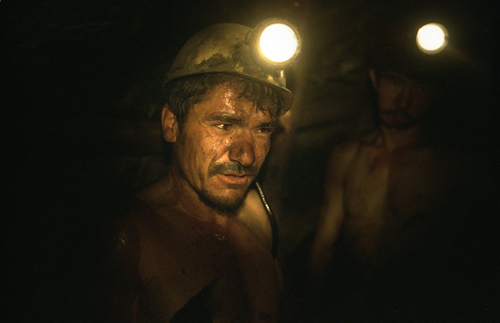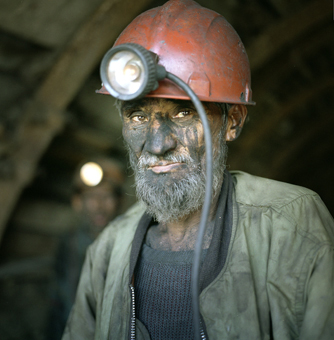G: Did you photograph the children working?
B: Well, yes, I did a project that became a travel tour called "Forced Destiny" and it had several exhibitions between Seattle and Vancouver, B.C. It was also publicized and shown on national TV in Canada. Because of the success of these exhibits, I received some funding to do a story on the labor situation in a very large coal mine called Karkar in Afghanistan, near the town of Pol-e-Khomil.
G: So, what did you see in the mines?
B: Well, it was interesting. The mine was built by the Russians--or actually it was built by Afghan engineers who were sent for 6 months to train in Czechoslovakia, which was under Soviet control at the time. So they created endless miles of galleries filled with coal. And today the mine is still filled with coal. So basically we went through the rail tracks, going down a steep incline to about 1 kilometer underneath the earth. Some of the galleries were dangerous due to gasses. I was not allowed to use a flash. In some galleries I could not use my camera because it was so humid that within seconds my camera would be all wet. So from gallery to gallery, the situation would be so different. And everything was built by hand. The galleries were supported by logs that were imported all the way from Czechoslovakia. Some of the support beams were cracked from the weight of the earth, and sometimes you would see the rail tracks abruptly stopping at a wall, where a wall fell and cut the track. Sometimes, to get from gallery to gallery, we had to crawl like rats.
G: What were the working conditions?
B: People were working in pitch black with picks and shovels. There were no machines. Except for steel wagons that they put the coal in. The wagons were attached one to another, and the first wagon was attached to a cable that is led about one kilometer away by a machine. They would talk to each other by radio. And along the way there were canvas tubes that were bringing in fresh air for people to breathe. It was quite intense. So the mine during the Soviet occupation had over 2500 miners. In 2005 there were about 150. There was a map on the wall that made clear the vastness of this once-exploited mine. Today, however, there is no infrastructure to support the industry, so the only trucks coming through those trails going to the mine are trucks using it for the local economy. The coal today is used by brick factories. They have dug a big hole and they put thousands of bricks in there, and then they use the coal to heat the space up and cook the bricks. And after a week they take the cooked bricks out and transport them with donkeys. Everything is done by hand, or with animal labor.The severe conditions are hugely exacerbated by the total lack of infrastructure.
G: So, what do you want to get when you go back to Afghanistan, that you haven't got yet?
B: Well I don't have all the stories I'm looking for. This portrait project is called "Forbidden Faces." -- those portraits and the stories behind them that are being forbidden by the Taliban. It gives voice to the Pashtun to tell whatever they want to tell.
G: Is it dangerous for them to allow you to photograph them?
B: I know they have a tremendous decision as to whether they want to participate in the project. The area where I am taking the portraits is one of the busiest. So, often when they come forth they look around to see who else might be watching.
G: Do they want or expect to receive their own copy of their portrait?
B: No, I don't think it's important for them to have their own copies, they don't often ask for that. But I do believe it is important for them to say something. Most of them are eager to speak. If you give them a chance they will always speak about everything.
G: Do they know that people will see their portraits in other countries such as the US?
B: Well, yes, they know that's the reason I am there. They may not understand the way we are going to interpret them. But I think they do understand the basics. That up till now, their stories are untold… since for the most part, for us, their personal stories are overshadowed by the war against the Taliban.
G: From the stories you've already gathered, are there any specific stories that you'd especially like to tell me?
B: No, not any one in particular. They are ordinary people. They are ordinary to each other, so they should be ordinary to us. That's the point. They are ordinary people, but they might still have something complex to say about life under the Taliban in their region. Or their views on poetry or music. But these are still the views of ordinary people. In the context of the show, their stories will complement their photographs, but I don't want to artificially elevate the significance of any one subject's story here.
G: And aren't you planning to lead a group on a new trip to Pakistan soon?
B: Yes. The itinerary is a 14-day photography expedition open to anyone interested in exploring the Northern territories of Pakistan, which are very isolated.
G: Is it Pashtun?
B: No, these people are called Kalash. Supposedly they are descended from the ancient Greeks. Actually they have a very strange set of religious rituals that looks like it includes aspects from the the Greek myths that we are familiar with.
G: Wow.
B: Yeah, there are only 3000 Kalash left. I'm still finishing up organizing the itinerary for this tour. I do know that at the end we will spend some time in Peshawar to get a taste of Pashtun culture before returning to U.S.A.




